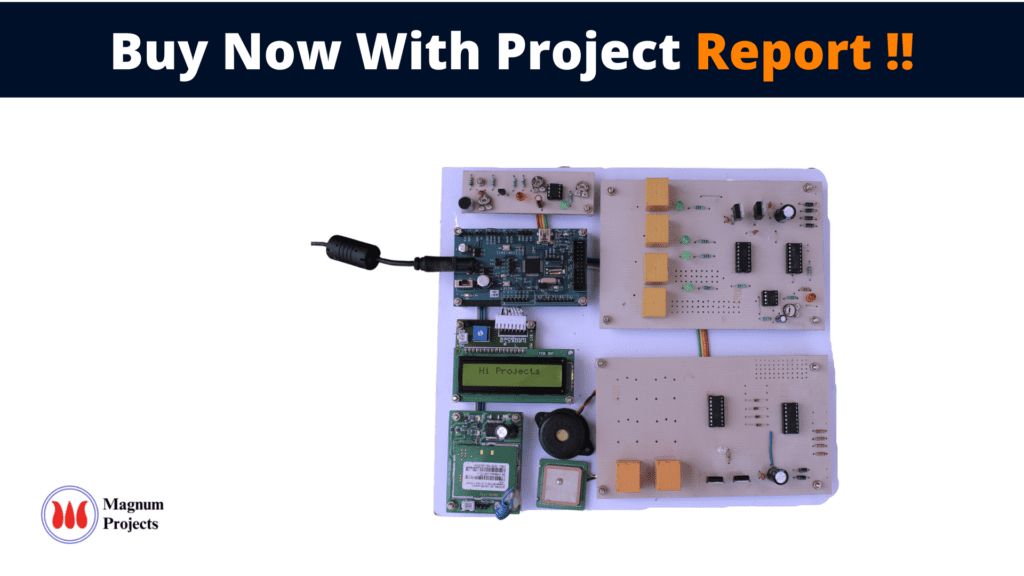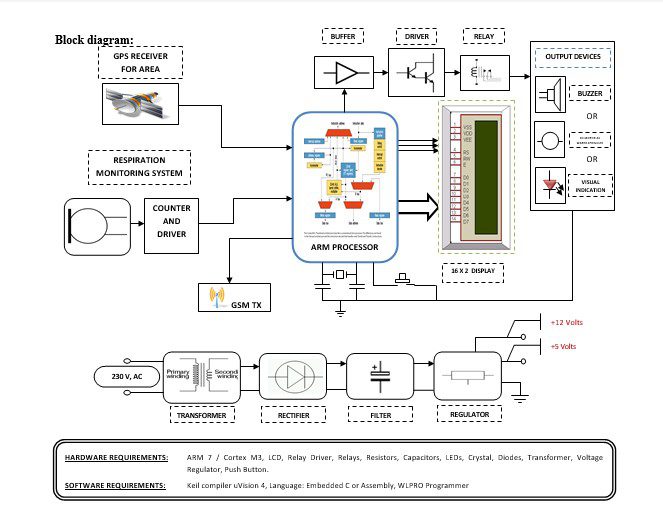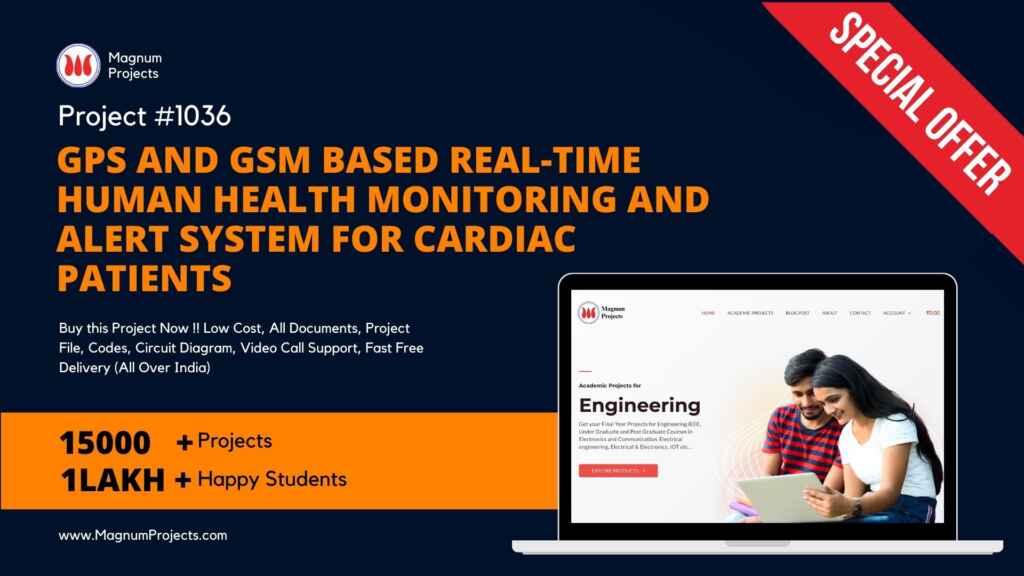Table of Contents
Introduction:

This project aims in sending alert messages in emergency times, i.e. when a person is alone at home or traveling and his heartbeat or body temperature rises or lowers then alerting messages will be sent to the mobile phone, the message consists of the location of that person also. Also, we can get the heart rate of the person by simply sending a pre-defined format SMS. Here we get the alerting message from the GSM modem (SMS Message) and the location of that person can be found with the help of GPS. The GPS is the acronym for Global positioning system. GPS gives the Position, velocity, and time of anything located on the Earth. This GPS receiver is capable of identifying the location in which it was present in the form of latitude and longitude.
The GPS receiver gets the data from the satellites. The functioning of this device is based on the truth that the blood level circulation during the expansion and contraction of the heart can be sensed by the Heartbeat sensor. Depending upon the rate of circulation of blood per second the heart beat rate per minute is calculated. This device consists of a microcontroller that takes input from the heartbeat sensor and calculates the heart rate of the patient. The microcontroller takes the responsibility of sending alert messages through the GSM modem whenever it is necessary. The Microcontroller is programmed using Embedded C language.

Block diagram explanation :
Power supply unit:
This section needs two voltages viz., +12 V & +5 V, as working voltages. Hence specially designed power supply is constructed to get regulated power supplies.
GPS module:
This is a GPS Receiver (5V Serial) with high gain having 4 Pin 2.54mm pitch strip. The third-generation POT (Patch Antenna on Top) is used by the receiver for the GPS module. It can be interfaced with normal 5V ARM7 with the help of the in-built 3V-5V converter. The interfacing is made easier with the help of a low pin count (4-pin) strip. The 4 Pins are 5V, TX, RX, and GND. This standalone 5V GPS Module does not require external components. It consists of an internal RTC Back up battery and can be directly connected to the USART of the ARM7.
The current date, time, longitude, latitude, altitude, speed, and travel direction / heading among other data, are provided by the module and can be used in many applications including navigation, fleet management, tracking systems, mapping, and robotics. The module can support up to 51 channels. The GPS solution enables small form factor devices which deliver major advancements in GPS performance, accuracy, integration, computing power, and flexibility. They are used to simplify the embedded system integration process.
GSM:
GSM Shield (SIM 900a): The SIM900 which is a complete Quad-band GSM/GPRS solution comes in a SMT module that can be embedded in customer applications. Featuring an industry-standard interface, the SIM900 delivers GSM/GPRS 850/900/1800/1900MHz performance for Data, voice, SMS, and Fax in a small form factor and with low power consumption. SIM900 can fit almost all the space requirements in the M2M application with dimensions of 24mm x 24mm x 3 mm. SIM900 is designed with a very powerful single-chip processor integrating AMR926EJ-S core. Quad-band GSM/GPRS module with a size of 24mmx24mmx3mm, SMT type suit for customer application, An embedded Powerful TCP/IP protocol stack Based upon the mature and field-proven platform, backed up by our support service, from definition to design and production.
NOTE: Modem may change.
ARM processor:
ARM is a computer processor-based RISC architecture. A RISC-based computer design approach means ARM processors require significantly fewer transistors than typical processors in average computers. This approach reduces costs, heat, and power use. The low power consumption of ARM processors has made them very popular:
The ARM architecture (32-bit) is the most widely used in mobile devices, and the most popular 32-bit one in embedded systems.
ARM processor features include:
- Load/store architecture.
- An orthogonal instruction set.
- Mostly single-cycle execution.
- A 16×32-bit register.
- Enhanced power-saving design.
Buffers:
Buffers do not affect the logical state of a digital signal (i.e. a logic 1 input results in a logic 1 output whereas logic 0 input results in a logic 0 output). Buffers are normally used to provide extra current drive at the output but can also be used to regularize the logic present at an interface.
Drivers:
This section is used to drive the relay where the output is the complement of input which is applied to the drive but the current will be amplified.
Relays:
It is an electromagnetic device that is used to drive the load connected across the relay and the o/p of the relay can be connected to the controller or load for further processing.
Indicator:
This stage provides a visual indication of which relay is actuated and deactivated, by glowing respective LED or Buzzer.
Sensors:
Sensors are used to sense/detect the value of the physical parameter under observation. Here several sensors are used for analyzing the parameters like, Respiration monitoring.
Methodology:
Our project is a model which incorporates sensors to measure parameters like body temperature, and heartbeat rate, and transfer them to the patient’s mobile phone which has software that contains predefined limits of both the parameters, and continuous monitoring of those parameters is carried out. The link between the patient who has to carry a circuit with him. Once there is any sort of deviation in the parameters, then the patient’s mobile will immediately send an SMS to a predefined Number(Doctor) containing the value of the parameter which has deviated along with the patient’s GPS coordinates. The GPS coordinates will be sent only if the patient’s phone is a GPS-enabled Phone.
Advantages:
- The staying of specialists is eliminated.
- It is multipurpose so that overall conditions are easily measured.
- Easy to operate.
- Compare with compact sensors it gives better performance.
- Modern technologies have developed that promote a comfortable and better life that is disease free.
Disadvantages:
- The only thing that is clear about constitutional protections for location-based service information is the lack of clarity
Applications:
- Home-based nocturnal dialysis.
- Cardiac and multi-parameter monitoring of remote ICUs.
- Home telehealth.
- Disease management.




